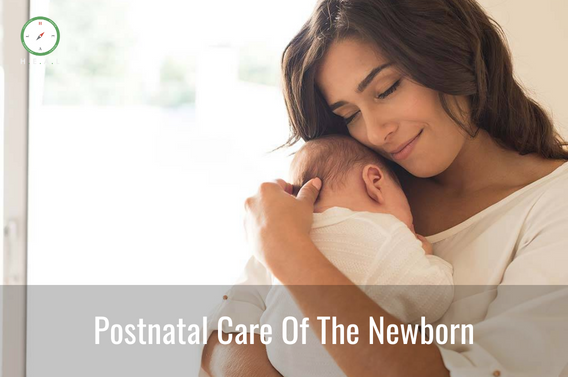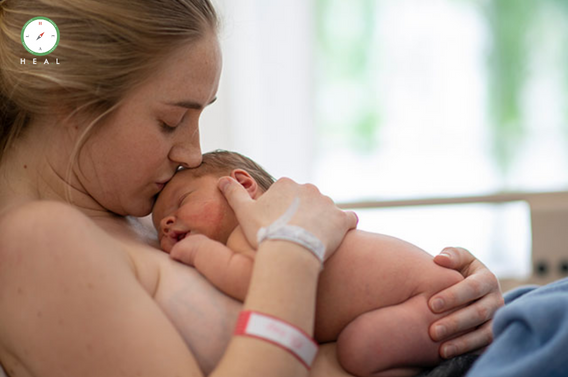World health organization stated that postnatal care is defined as care given to the mother and her newborn baby immediately after the birth of the placenta and for the first six weeks of life. The majority of maternal and neonatal deaths occur during childbirth and the postnatal period with no proper baby care after delivery.

Broadly, the major elements of postnatal care include counseling and health education on the recognition of danger signs and appropriate care-seeking for both newborn and mother too. Counseling and health education on routine care practices such as exclusive breastfeeding and good thermal care practices.
1. Providing warmth for the newborn:
A newborn baby is wet from the amniotic fluid and can easily become cold. Drying the baby and using warm blankets and heat lamps can help prevent heat loss. Often a knitted hat is placed on the baby’s head. Placing a baby skin-to-skin on your chest or abdomen also helps the baby warm. This early skin-to-skin contact also reduces crying, improves your interaction with your baby, and helps you to breastfeed successfully
2. Immediate care for the newborn:

Health assessment of the new baby start right away. One of the first checks is the Apgar test. The Apgar test is a scoring system to evaluate the condition of the newborn at 1 minute and 5 minutes after birth. The healthcare provider or midwife and nurses will evaluate these signs and give a point value.
Activity; muscle tone
Pulse rate
Grimace; reflex irritability
Appearance; skin color
Respiration
A score of 7 to 10 is considered normal. A score of 4 to 6 may mean that the baby needs rescue breathing measures (oxygen) and careful monitoring. A score of 3 or below means that the baby needs rescue breathing and lifesaving techniques.
3. Physical exam of the newborn in the delivery room:
A brief, physical exam is done to check for obvious signs that the baby is healthy. Other procedures are to be done within the next few minutes and hours. These may be done in the delivery room, in the nursery, or in the homeroom, depending on the hospital policy and the condition of the baby.
Measurement of the temperature, heart rate, and respiratory rate
Measurement of weight, length, and circumference. These measurements help find out if the baby’s weight and measurements are normal for the number of weeks of pregnancy. Small or underweight babies and very large babies need special attention and care.
Cord care. The baby’s umbilical cord stump will have a clamp. It needs to be kept clean and dry.
Bath. Once the baby’s temperature has stabilized, the first bath can be given.
Eye care. Bacteria in the birth canal can infect a baby’s eyes. Your baby will be given antibiotic or antiseptic eye drops or ointment either right after delivery or later in the nursery to prevent eye infection.
Footprints. These are often taken and recorded in the medical record.
4. Care for the newborn after vaginal delivery:

Healthy babies born in a vaginal delivery are usually able to stay with the mother. In the hospitals, immediate newborn assessments include weight, length, and medicines. Even the first bath is done right in your room. As quickly as possible, a new baby is placed in your arms. Often, the baby is placed skin-to-skin on your chest right after birth. Some babies will breastfeed right away.
5. Care for the newborn after a C-section:
If your baby is born by a cesarean, chances are good that can be awake for the surgery. Only in rare cases will need general anesthesia for delivery. This means that the mother is not awake for the birth. Babies born by C-section are usually checked by a nursery or healthcare provider right after the delivery.
6. When babies have trouble after birth:
All the baby’s body systems must work together in a new way after birth. Sometimes a baby has trouble making the transition. Health assessments such as the Apgar test done right after birth can help to find out if the baby is doing well or having some kind of problem.
Vidhi Beri is a renowned Global Educator and Specialist in the fields of Holistic Health, Lactation, Maternal Health Wellness, Child Nutrition, and Children's Milestone Development with effective and well-structured maternity wellness programs offered to the new wave of freshly home-grown Indian mommies and babies, with her desi tadka of Ancient Indian sciences in her latest book, Decoding Motherhood, one of the best Maternity books India. Visit Vidhi Beri’s official website to know more- https://www.vidhiberi.com/